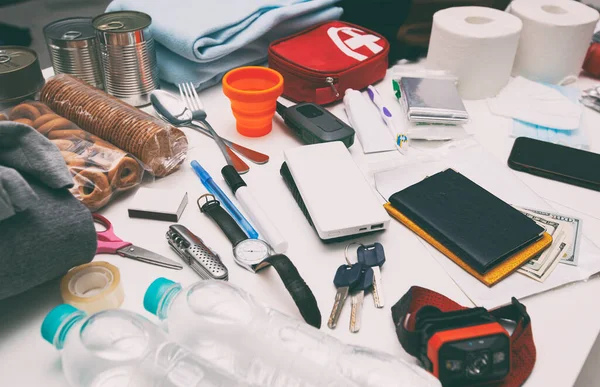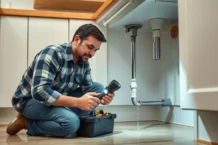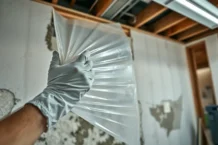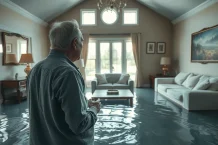Water Damage Emergency Kit – Gold Coast Flood Restorations – San Diego CA
Having a well-prepared emergency kit can make all the difference when disaster strikes. In the case of water damage, having the right items on hand can help protect your home and belongings from further harm. This article will highlight five essential items to include in your water damage emergency kit to help you tackle the situation effectively.
First and foremost, a high-quality wet/dry vacuum is a must-have tool. It will help you remove standing water and prevent further damage to your property. Secondly, make sure to include plenty of absorbent materials, such as towels, rags, and absorbent pads. These will help soak up excess moisture and prevent mold growth.
Next, include a moisture meter to detect hidden water damage in walls, floors, and ceilings. This will help you identify areas that need immediate attention and reduce the risk of long-term damage. Additionally, don’t forget to include a portable dehumidifier to remove excess moisture from the air and speed up the drying process.
Lastly, having a digital camera or smartphone with a good camera is essential for documenting water damage for insurance claims. Remember to take photos of the affected areas before you start cleaning up.
By including these five essential items in your water damage emergency kit, you’ll be better equipped to handle any water-related emergencies that come your way.
Water Damage Emergency Kit Essentials:
1. High-Quality Wet/Dry Vacuum: A wet/dry vacuum is a versatile tool for removing standing water from floors, carpets, and other surfaces. Look for a vacuum with a powerful motor and various attachments to make the cleanup process easier and more efficient. A wet/dry vacuum can also help prevent water damage from spreading and minimize the risk of mold growth.
2. Absorbent Materials: Include plenty of towels, rags, and absorbent pads in your emergency kit to soak up excess moisture. These materials can help prevent water from seeping into walls, floors, and furniture, reducing the risk of water damage and mold growth. Make sure to replace the absorbent materials regularly to maintain their effectiveness.
3. Moisture Meter: A moisture meter is valuable for detecting hidden water damage in hard-to-reach areas. By measuring the moisture levels in walls, floors, and ceilings, you can identify areas that need immediate attention and prevent further damage. A moisture meter can also help you track the progress of the drying process and ensure that all affected areas are thoroughly dry.
4. Portable Dehumidifier: A portable dehumidifier is essential for removing excess moisture from the air and speeding up the drying process. Excess humidity can prolong the drying time and create an ideal environment for mold growth. By using a dehumidifier, you can maintain a low humidity level in your home and prevent mold and mildew from forming.
5. Digital Camera or Smartphone: Documenting the water damage is crucial for insurance claims and restoration purposes. A digital camera or smartphone with a good camera can help you capture clear and detailed photos of the affected areas before you start cleaning up. Make sure to take photos from multiple angles to provide a comprehensive record of the damage.
Water Damage Emergency Kit Checklist:
Creating a water damage emergency kit is a proactive step towards protecting your home and belongings in a water-related emergency. Here is a checklist of essential items to include in your kit:
- High-quality wet/dry vacuum
- Absorbent materials such as towels, rags, and absorbent pads
- Moisture meter
- Portable dehumidifier
- Digital camera or smartphone with a good camera

In addition to these essential items, consider adding the following supplies to your water-damage emergency kit:
1. Rubber gloves and protective clothing
2. Trash bags for disposing of damaged materials
3. Plastic sheeting and tarps for temporary repairs
4. Duct tape and scissors
5. Flashlights and extra batteries
6. First aid kit
7. Emergency contact numbers and insurance information
8. Waterproof storage containers for important documents and valuables
9. Cleaning supplies such as disinfectant, bleach, and gloves
10. Non-perishable food and water
Regularly check and maintain your water damage emergency kit to ensure that all items are in good working condition and up to date. Replace expired supplies and batteries as needed to keep your kit fully stocked and ready for any water-related emergencies that may arise.
Where to Store Your Water Damage Emergency Kit:
The location of your water damage emergency kit is just as important as its contents. Store your kit in a readily accessible and easily identifiable location to ensure that you can quickly grab it in case of an emergency. Consider the following tips for storing your water-damage emergency kit:
1. Near Water-Prone Areas: Keep your emergency kit in an area susceptible to water damage, such as the basement, laundry room, or under sinks. Storing the kit near potential sources of water leaks can help you respond quickly to emergencies and prevent extensive damage.
2. Elevated and Dry: Store your emergency kit on elevated surfaces or shelves to protect it from potential water damage. Avoid placing the kit directly on the floor, as flooding or leaks can render the supplies unusable. Choose a dry and well-ventilated area to prevent moisture buildup and mold growth.
3. Easy to Access: Ensure that your emergency kit is easily accessible in an emergency. Avoid placing the kit in hard-to-reach or cluttered areas that may impede your ability to retrieve it quickly. Consider storing the kit in a waterproof container or bag for added protection against water damage.
4. Labeling and Organization: Clearly label your water damage emergency kit with a bright, recognizable sign. Organize the supplies in the kit logically, with frequently used items at the top for quick access. Regularly check the kit’s contents and replace any expired or damaged items.
DIY vs. Pre-Made Water Damage Emergency Kits:
When it comes to preparing for water-related emergencies, you can either create your emergency kit or purchase a pre-made kit. Both DIY and pre-made kits have their advantages and drawbacks, so it’s essential to consider your needs and preferences before making a decision.
DIY Water Damage Emergency Kit:
⦁ Customization: One of the main benefits of creating your emergency kit is the ability to customize it to suit your needs. You can choose the items and supplies that are most relevant to your home and environment, ensuring that you are well-prepared for any water-related emergencies.
⦁ Cost-Effective: Building your emergency kit can be more cost-effective than purchasing a pre-made kit, especially if you already have some of the supplies on hand. You can shop for deals and discounts to assemble a comprehensive kit without breaking the bank.
⦁ Personalization: DIY kits allow you to personalize the contents based on your family’s unique needs and preferences. You can include items that are essential for your household, such as medications, pet supplies, or specific tools that may not be included in pre-made kits.
Pre-Made Water Damage Emergency Kit:
⦁ Convenience: Pre-made kits offer the convenience of having all the essential supplies bundled together in one package. This can save you time and effort in assembling the kit, especially if you are short on time or unsure what items to include.
⦁ Comprehensive Coverage: Pre-made kits are often designed by experts in emergency preparedness and may include items that you might not have considered. These kits are typically well-rounded and cover a wide range of potential emergencies, providing you with peace of mind and thorough protection.
⦁ Ready to Use: Pre-made kits are ready to use right out of the box, making them ideal for those who want a hassle-free solution to emergency preparedness. You can purchase a kit and store it in a convenient location, knowing that you are prepared for any water-related emergencies that may arise.
Ultimately, whether you create your water damage emergency kit or purchase a pre-made kit, the most important thing is to ensure that you have the necessary supplies to respond effectively to water-related emergencies. Evaluate your needs, budget, and level of preparedness to determine which option is the best fit for you and your household.
Additional Items to Consider for Your Water Damage Emergency Kit:
In addition to the essential items listed earlier, there are several additional supplies that you may want to consider including in your water damage emergency kit. These items can enhance your preparedness and help you effectively tackle water-related emergencies. Here are some additional items to consider for your kit:
1. Rubber Gloves and Protective Clothing: Wear rubber gloves, goggles, and protective clothing to protect yourself from exposure to contaminated water and mold. These items can help prevent skin irritation and respiratory issues after water damage.
2. Trash Bags and Plastic Sheeting: Use heavy-duty trash bags to dispose of damaged materials and contaminated items. Plastic sheeting and tarps can be used to cover exposed areas and prevent further water intrusion, especially in the case of roof leaks or broken windows.
3. Duct Tape and Scissors: Keep a roll of duct tape and a pair of scissors in your emergency kit for quick repairs and temporary fixes. Duct tape can seal leaks, patch holes, and secure plastic sheeting, while scissors are essential for cutting materials and creating makeshift solutions.
4. Flashlights and Extra Batteries: In a power outage or flooding, flashlights and extra batteries can provide essential light and visibility. Make sure to test your flashlights regularly and replace the batteries as needed to ensure they are in working condition.
5. First Aid Kit: Accidents can happen during cleanup efforts, so having a fully stocked first aid kit in your emergency supplies is crucial. Include bandages, antiseptic wipes, gauze pads, and other basic medical supplies to treat minor injuries and wounds.
6. Emergency Contact Numbers and Insurance Information: Keep a list of emergency contact numbers, including local authorities, utility companies, and restoration services. Also, store a copy of your insurance policy and contact information in your emergency kit for easy reference during emergencies.
7. Waterproof Storage Containers: Store important documents, valuables, and electronic devices in waterproof containers to prevent water damage. Consider using sealable bags or plastic bins to keep these items safe and dry in case of flooding or leaks.
8. Cleaning Supplies: Include disinfectant, bleach, gloves, and other cleaning supplies in your emergency kit to sanitize and disinfect affected areas. Proper cleaning and disinfection can help prevent mold growth and microbial contamination after water damage.
9. Non-Perishable Food and Water: It’s important to have non-perishable food and water on hand in an extended power outage or evacuation. Keep canned goods, energy bars, bottled water, and other shelf-stable foods in your emergency kit to sustain you during emergencies.
By including these additional items in your water damage emergency kit, you can enhance your preparedness and ensure that you are well-equipped to handle a variety of water-related emergencies. Regularly review and update your kit to ensure all supplies are in good condition and ready for use in an emergency.
How to Maintain and Update Your Water Damage Emergency Kit
Once you have assembled your water damage emergency kit, it’s essential to maintain and update it regularly to ensure it remains effective and ready for use in an emergency. Here are some tips for maintaining and updating your water damage emergency kit:
1. Regular Inspections: Check your emergency kit periodically to ensure that all items are in good working condition and have not expired. Inspect the supplies for any signs of damage, leaks, or contamination, and replace any items that are no longer usable.
2. Expiration Dates: Track the expiration dates of perishable items in your emergency kit, such as batteries, medications, and food supplies. Replace expired items promptly to ensure your kit is fully stocked and ready for emergencies.
3. Seasonal Updates: Update your emergency kit seasonally to account for changing weather conditions and potential hazards. Consider adding items such as blankets, warm clothing, hand warmers, or sunscreen based on the time of year and local climate.
4. Family Needs: Review your family’s specific needs and adjust your emergency kit. Include items such as baby supplies, pet food, medications, or medical equipment that may be essential for your household members.
5. Training and Practice: Familiarize yourself and your family members with the contents of the emergency kit and how to use them effectively in an emergency. Conduct regular drills and practice scenarios to ensure everyone knows where the kit is located and how to access it quickly.
6. Documentation and Records: Keep a detailed inventory of the items in your emergency kit, including purchase dates, expiration dates, and usage instructions. Store important documents such as insurance policies, contact numbers, and emergency plans in a waterproof container within your kit.
7. Emergency Plan Review: Review your overall emergency preparedness plan and ensure that your water damage emergency kit aligns with your evacuation routes, communication strategies, and safety protocols. Update your emergency contacts and procedures to reflect changes in your household or local area.
Maintaining and updating your water damage emergency kit regularly ensures you are well-prepared to respond effectively to water-related emergencies. Stay proactive and vigilant in keeping your kit stocked, organized, and ready for any situation that may arise.
The Benefits of Having a Water Damage Emergency Kit:
Investing in a water damage emergency kit offers a myriad of benefits that can help you protect your home, belongings, and loved ones in the event of a water-related emergency. Here are some key benefits of having a water-damage emergency kit:
1. Quick Response: With a well-equipped emergency kit, you can respond quickly to water damage incidents and prevent further harm to your property. Immediate action can help minimize the extent of the damage and reduce the need for costly repairs and restoration.
2. Reduced Health Risks: Standing water and excess moisture can create an environment conducive to mold growth and bacterial contamination. Having the right tools and supplies in your emergency kit can mitigate health risks and create a safe and healthy living space for your family.
3. Financial Protection: Water damage can lead to significant financial losses due to property damage, restoration costs, and potential health issues. By having a water damage emergency kit, you can limit the financial impact of emergencies by addressing the situation promptly and effectively.
4. Peace of Mind: Knowing you are well-prepared for water-related emergencies can provide peace of mind and confidence in handling unforeseen situations. Having a comprehensive emergency kit at your disposal can alleviate stress and uncertainty during emergencies.
5. Versatility and Adaptability: A water damage emergency kit can be customized to meet your specific needs and address a variety of emergency scenarios. Whether dealing with a minor leak or a major flood, having the right supplies on hand can help you adapt to different situations and respond effectively.
6. Community Resilience: Being prepared for emergencies benefits you and your family and contributes to your community’s resilience. By taking proactive steps to protect your home and belongings, you can help reduce the overall impact of disasters on your neighborhood and support recovery efforts.
Overall, a water damage emergency kit is a proactive and practical investment that can help you navigate water-related emergencies confidently and quickly. By prioritizing emergency preparedness and equipping yourself with the necessary tools and supplies, you can safeguard your home and loved ones from the potentially devastating effects of water damage.
Water Damage Preparedness Tips:
In addition to having a water damage emergency kit, several preparedness tips can help you minimize the risk of water damage and respond effectively to emergencies. Here are some practical tips to enhance your water damage preparedness:
1. Regular Maintenance: Protect your home’s plumbing, roof, and appliances to prevent water leaks and damage. Inspect pipes, gutters, and seals regularly for signs of wear or deterioration and address any issues promptly to avoid potential water-related emergencies.
2. Weatherproofing: Prepare your home for inclement weather by weatherproofing doors, windows, and exterior walls. Seal cracks, gaps, and openings to prevent water intrusion during heavy rain or storms. Consider installing a sump pump or a backwater valve to protect your basement from flooding.
3. Monitor Indoor Humidity: Keep an eye on indoor humidity levels to prevent excess moisture buildup and mold growth. Use a dehumidifier in damp areas of your home, such as basements and bathrooms, to maintain a healthy humidity level and reduce the risk of water damage.
4. Emergency Notifications: Sign up for local emergency alerts and notifications to stay informed about potential water-related hazards in your area. Be aware of flood risks, severe weather warnings, and evacuation orders, and have a communication plan for emergencies.
5. Emergency Evacuation Plan: Develop an emergency evacuation plan for your family that includes evacuation routes, meeting points, and communication strategies. Practice the plan regularly with all household members to ensure everyone knows what to do in a water-related emergency.
6. Insurance Coverage: Review your homeowner’s insurance policy to understand your coverage for water damage and emergencies. If you live in a high-risk area, consider purchasing flood insurance or updating your policy to include additional protection against water-related hazards.
7. Professional Inspection: Schedule regular inspections and maintenance checks with certified professionals to assess the condition of your home’s plumbing, roof, and foundation. Address any issues identified during inspections promptly to prevent water damage and ensure the integrity of your home.
By following these preparedness tips and incorporating them into your overall emergency plan, you can enhance your resilience to water-related emergencies and protect your home and loved ones from potential harm. Stay informed, proactive, and prepared to respond effectively to unexpected water damage incidents.
Conclusion:
In conclusion, having a well-equipped water-damage emergency kit is essential for protecting your home, belongings, and family in a water-related emergency. By including essential items such as a wet/dry vacuum, absorbent materials, a moisture meter, a dehumidifier, and a digital camera in your emergency kit, you can respond quickly and effectively to water damage incidents. Regularly maintain and update your kit to ensure that it remains fully stocked and ready for any emergency that may arise.
Whether you choose to create your own DIY emergency kit or purchase a pre-made kit, the key is to prioritize preparedness and ensure that you have the necessary tools and supplies to address water-related emergencies. Following water damage preparedness tips, monitoring indoor humidity levels, and developing an emergency evacuation plan can enhance your resilience to water damage and minimize the risks to your home and loved ones.
Investing in a water damage emergency kit provides practical benefits such as quick response, reduced health risks, financial protection, peace of mind, and community resilience. By taking proactive steps to prepare for water-related emergencies, you









Follow Us!